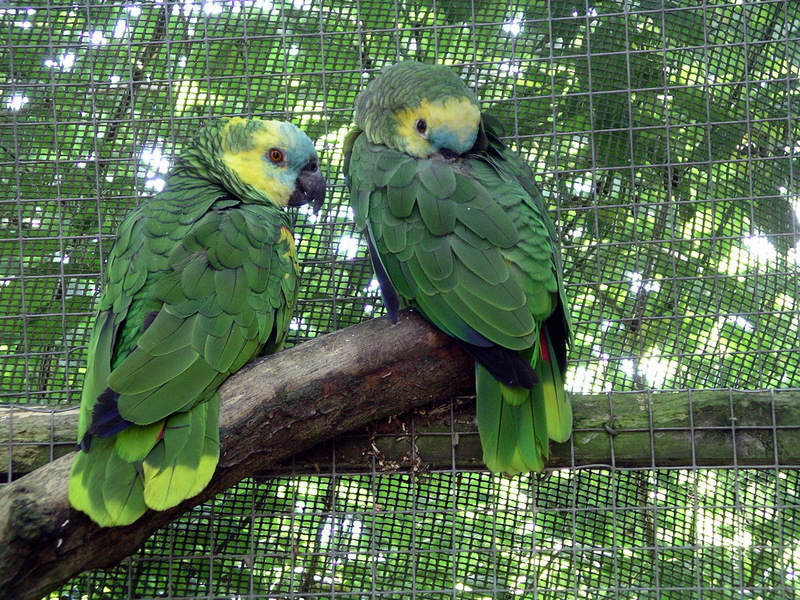|
| 질의: Wood white | 결과: 193번째/203 | |
Amazon Parrot (Family: Psittacidae, Genus: Amazona) - Wiki
| 제목: | Amazon Parrot (Family: Psittacidae, Genus: Amazona) - Wiki
| |

| 해상도: 1296x972
파일크기: 829383 Bytes
촬영일: 2007:07:31 15:43:46
사진기: PENTAX Optio 550 (PENTAX Corporation)
F number: f/2.8
Exposure: 10/100 sec
Focal Length: 325/10
등록시간: 2007:09:04 22:33:58
|
Amazon parrot
From Wikipedia, the free encyclopedia
[Photo] A pair of Blue-fronted Amazons (Amazona aestiva) at Tropical Birdland, Leicestershire, England. Date photo taken on 31 July 2007. Author Snowmanradio http://commons.wikimedia.org/wiki/User:Snowmanradio
An Amazon parrot is a large parrot of the genus Amazona native to the New World ranging from South America to Mexico and the Caribbean.
Most Amazons are predominantly green, with accenting colors that depend on the species and can be quite vivid. Amazons, like all parrots, are zygodactyl, having four toes on each foot???two front and two back. They feed primarily on nuts and fruits, supplemented by leafy matter.
Several amazon species are commonly kept as pets, including the Yellow-headed Amazon, Yellow-naped Amazon, and Blue-fronted Amazon.
Amazons are known for their exceptional vocal abilities, playfulness, and dexterity with their feet. They are very loyal, loving companions; having them is somewhat like having a two-year-old human child in ability and temperament for 50-plus years. However, some Amazons are aggressive (usually during their mating time), and they all require a lot of attention when kept as pets. Parrots require more attention and care than domesticated pets such as dogs or cats, and are not for the inexperienced bird owner. All parrots need a lot of stimulating activities to keep from being bored and terribly destructive to themselves and their surroundings. In particular, since Amazons are cavity nesters in the wild, their desire to chew wood is strong, and they need to be provided with destructible toys to satisfy this innate urge.
Classification
Cuban Amazon, Amazona leucocephala
Yellow-billed Amazon, Amazona collaria
Hispaniolan Amazon, Amazona ventralis
Puerto Rican Amazon, Amazona vittata
Yellow-lored Amazon, Amazona xantholora
White-fronted Amazon, Amazona albifrons
Black-billed Amazon, Amazona agilis
Tucum??n Amazon, Amazona tucumana
Red-spectacled Amazon, Amazona pretrei
Red-crowned Amazon, Amazona viridigenalis
Lilac-crowned Amazon, Amazona finschi
Red-lored Amazon, Amazona autumnalis
Blue-cheeked Amazon, Amazona dufresniana
Red-browed Amazon, Amazona rhodocorytha
Red-tailed Amazon, Amazona brasiliensis
Festive Amazon, Amazona festiva
Yellow-shouldered Amazon, Amazona barbadensis
Blue-fronted Amazon, Amazona aestiva
Yellow-headed Amazon, Amazona oratrix
Yellow-crowned Amazon, Amazona ochrocephala
- Yellow-naped Amazon, Amazona (ochrocephala) auropalliata
Kawall's Amazon, Amazona kawalli
Orange-winged Amazon, Amazona amazonica
Scaly-naped Amazon, Amazona mercenaria
Mealy Amazon, Amazona farinosa
Vinaceous Amazon, Amazona vinacea
St Lucia Amazon, Amazona versicolor
Red-necked Amazon, Amazona arausiaca
St. Vincent Amazon, Amazona guildingii
Imperial Amazon, Amazona imperialis
Martinique Amazon, Amazona martinica (extinct)
Guadeloupe Amazon, Amazona violacea (extinct)
The following species was originally placed within this genus, however, recent research suggests that it belongs to its own separate genus Salvatoria:
Yellow-faced Amazon, Salvatoria xanthops
The Amazona ochrocephala species historically contained many sub-species, such as auropalliata and oratrix. However, new taxonomic classification puts those in their own species.
http://en.wikipedia.org/wiki/Amazon_parrot
| The text in this page is based on the copyrighted Wikipedia article shown in above URL. It is used under the GNU Free Documentation License. You may redistribute it, verbatim or modified, providing that you comply with the terms of the GFDL. |
|
^o^
동물그림창고 똑똑전화 누리집
^o^
|
|

